A taste of Manaus
A Day in the life | Settlers | Hermit | Tapioca/Cassava | Meeting of Waters | Lists | Manaus | M/Y Tucano | Ecology | Maps
We had a whole day in Manaus before the trip, and another one afterwards, with 16 hours between disembarking after breakfast and the midnight plane departure. Home base both times was the “Hotel Tropical Manaus EcoResort” conveniently located walking distance from the embark-disembarkation landing for the Tucano, and only ten minutes from the airport. We know that because the English-speaking guide and bus we had negotiated to pick us up at the airport opened his trip narration with “Hi, my name is Jilton. I will be your guide for the next 9 minutes and 45 seconds.”
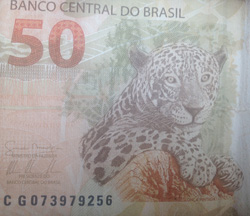 We know that it was an ecoresort because it had its own zoo, though in my head this is a conflict. Since becoming an ecotourist ten years ago, my various companions and I have resolved to find animals in their natural habitat, not in a cage, so to me a zoo represents the antithesis of ecotourism. Don’t get me wrong, I’m not against zoos as an institution, and if this one was playing a role in turning regular people into ecotourists, then bring it on. But for someone as lucky as me, with the health and wealth to travel, it adds to the challenge—and makes a “real” sighting that much more rewarding. I had a narrow escape on the last day when there was time on our hands. I was hanging out with Brian and Virginia, who expressed the desire to visit the zoo. Accompanying them was an easy decision, but a part of me was secretly delighted when we found it was shut. So the closest we got to seeing a jaguar was on the 50 Reais bill I used to pay my bar bill. We need to return, probably to the Pantanal, where the more open territory significantly raises the possibility of a sighting. To say nothing of making that sighting safer—meeting a jaguar in the jungle means meeting it at extremely close range, which one assumes is a really bad idea.
We know that it was an ecoresort because it had its own zoo, though in my head this is a conflict. Since becoming an ecotourist ten years ago, my various companions and I have resolved to find animals in their natural habitat, not in a cage, so to me a zoo represents the antithesis of ecotourism. Don’t get me wrong, I’m not against zoos as an institution, and if this one was playing a role in turning regular people into ecotourists, then bring it on. But for someone as lucky as me, with the health and wealth to travel, it adds to the challenge—and makes a “real” sighting that much more rewarding. I had a narrow escape on the last day when there was time on our hands. I was hanging out with Brian and Virginia, who expressed the desire to visit the zoo. Accompanying them was an easy decision, but a part of me was secretly delighted when we found it was shut. So the closest we got to seeing a jaguar was on the 50 Reais bill I used to pay my bar bill. We need to return, probably to the Pantanal, where the more open territory significantly raises the possibility of a sighting. To say nothing of making that sighting safer—meeting a jaguar in the jungle means meeting it at extremely close range, which one assumes is a really bad idea.
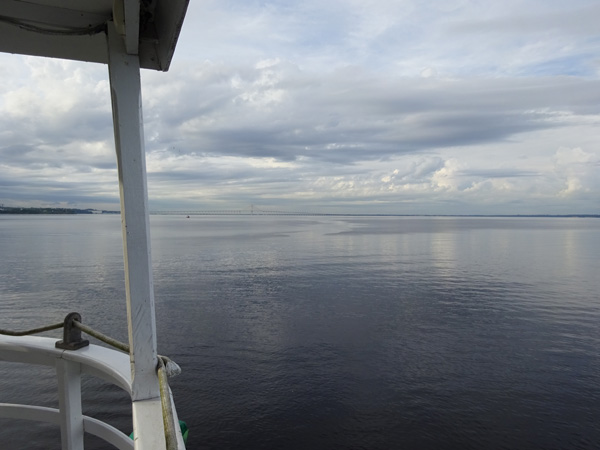 The Rio Negro bridge which you can just see on the horizon in this picture taken from the back of the moored Tucano dominates the city, but that is not the only reason it is a powerful symbol. It was only completed in 2010, and is the first and only bridge across the whole Amazon system. A contemporary article in the UK’s Guardian quotes a local resident who could not wait for it to open and reduce the $50 ferry fare to zero. The bridge brings obvious economic opportunities for those living on the far bank. But environmentalists fear that the bridge, combined with new gas pipelines, roads and rising populations, could open up the rainforest to further destruction.
The Rio Negro bridge which you can just see on the horizon in this picture taken from the back of the moored Tucano dominates the city, but that is not the only reason it is a powerful symbol. It was only completed in 2010, and is the first and only bridge across the whole Amazon system. A contemporary article in the UK’s Guardian quotes a local resident who could not wait for it to open and reduce the $50 ferry fare to zero. The bridge brings obvious economic opportunities for those living on the far bank. But environmentalists fear that the bridge, combined with new gas pipelines, roads and rising populations, could open up the rainforest to further destruction.
Until now, the motorcycles, flat screen TVs and mobile phones manufactured in Manaus for the whole of Brazil to say nothing of all the material to build the new World Cup soccer stadium have all travelled by ship. Now planned re-paving of an impassable 900km-long highway to the rich and populous south is almost inevitable. While the 25 million people in the Amazon, their local politicians and ferry-takers welcome the opening of the bridge, one has to wonder whether all these riches can be delivered while leaving the trees and cultures of the Amazon standing. An interesting feature then and one that many of us were curious enough about to stay up late to witness our passing under it on our way to the meeting of the waters.
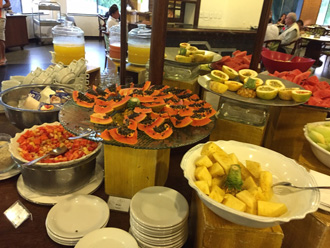 The Hotel Tropical did a great job with its buffet, and with the caipirinhas they prepared in the lobby bar, but other than that it had an oddly deserted feel, like a hangover from the glory days of the past. Long wide corridors, empty ballrooms, entire bars that never opened, a few stragglers at the pool, sometimes it felt like we were the only guests. The result was we spent a lot of time away from the hotel, and the rest of the time in the lobby bar drinking caipirinhas.
The Hotel Tropical did a great job with its buffet, and with the caipirinhas they prepared in the lobby bar, but other than that it had an oddly deserted feel, like a hangover from the glory days of the past. Long wide corridors, empty ballrooms, entire bars that never opened, a few stragglers at the pool, sometimes it felt like we were the only guests. The result was we spent a lot of time away from the hotel, and the rest of the time in the lobby bar drinking caipirinhas.
After discussing various options over breakfast on the first morning, the 14 passengers now gathered and united agreed on several different plans for this free day prior to boarding, and split up again. Lucy and Claudia were going to miss the city tour at the end of our trip because they were leaving the boat the night we got back and heading straight for the airport. They decided the one thing they wanted to see in Manaus was the Opera House, and Barb and Mary joined that expedition. Brian, Virginia, Adam and I decided that taking the bus into town was an adventure in its own right, and having done that we’d try to find the Museu do Índio (not to be confused with the more famous Museu da Amazonia). I asked for directions in the tourist office and they made the important discovery that the museum was not on the map. Not that it wasn’t marked, but that the map did not extend east of the city center far enough to show it. And of course there was no other map. So the nice ladies in the office did their best to describe the route, and we set off.
Finding and Visiting the Museo do Índio
The bus was hot and crowded, just as we’d hoped, and there was some pushing and shoving to get the right number of us squeezed through the turnstile half way down the bus. It was a 10 mile trip for $1, and the driver hurtled between the infrequent stops thus providing the best value entertainment of the day. We vainly tried to follow progress on the map, but gave up, figuring we’d know it when we got to the center. Oh yeah. The entire population of Manaus had turned out to meet us. The only problem was that the main bus terminal was one continuous stream of stops at least a quarter of a mile long. It was immediately clear that we’d never be able to figure out how to find the way home again.
Much like sailors of old who knew their latitude but not their longitude, we were fairly confident of what street we were on, but no idea how far we were along it. Although we were looking for a major street, no one we asked wanted to admit to having any idea where it was, so we set off at a tangent and hoped to hit it, which we did, within a block or so. We turned onto it, and within another short block the crowds had dwindled to nothing. It was hot, we walked slowly, as I generally do when I’m not entirely confident I’m heading in the right direction. Eventually, and in the nick of time, we came to a cross street that was labeled on the map. So now we knew where we were on the map: one street from the edge. After this fleeting confirmation we had nothing to go on but my memory of the garbled conversation in the tourist office. We stepped off the map.
“She said there was a bridge!” “She seemed uncertain if there was another bridge or not, and this looks like just such a spot.” We came to a very grand and well-maintained building. Not the museo, but the Palácio Rio Negro which we would shoot by again and recognize on our guided city tour. Here someone confirmed we were on the right track. Two more blocks take a left. Having taken the left, we found two guys who insisted on walking us one more block over, whereupon they were able to point at the building. Not a moment too soon. We were hot, tired, and thirsty, and the museu was shut. It was now closing on noon, and they did not open again until 2p. In unison we looked up and down the street, spotted the café/convenience store we had just passed, and looked at each other. Adam: “Right. Beers all round then.” Virginia was a little skeptical that we could wait out a whole two hours, but it proved to be fun. An authentic cultural experience, hanging out with a few locals at plastic tables and chairs under the shade of a dilapidated old awning stretched across the sidewalk. Part of the store was a buffet lunch counter and after watching a couple of folks plow through plates piled high with interesting looking fried things and shredded vegetables we caved in and bought a couple of plates to share. Free coffee, ready-sweetened in the thermos replaced the used plates when we were done. Before we knew it, it was 2pm. I think the whole affair, multiple beers and all, cost something like $15 between the four of us.
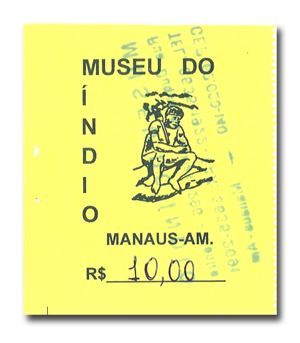 The Museo do Índio consists of several rooms with everyday tools and objects used by Indigenas - mainly Yanomamö, but also with tribes from the Xingu river (Mato Grosso). The entire collection turned out to belong to the Salesian Sisters who worked with these tribes. I was delighted to see Yonomami represented, as it was the fearsome tribe I remembered Redmond O'Hanlon quoting his friend Charlie Brewer-Carias describing: :
The Museo do Índio consists of several rooms with everyday tools and objects used by Indigenas - mainly Yanomamö, but also with tribes from the Xingu river (Mato Grosso). The entire collection turned out to belong to the Salesian Sisters who worked with these tribes. I was delighted to see Yonomami represented, as it was the fearsome tribe I remembered Redmond O'Hanlon quoting his friend Charlie Brewer-Carias describing: :
| 'Yeah. The most violent people on earth. Some anthropologists think they were the first peoples to reach South America from the North. They have very fair skins, occasionally green eyes. They are the largest untouched group of Indians left in the rain-forest. The other Indians are terrified of them. [...] It's all perfectly understandable--they grow a few plaintains, but basically they're hunter-gatherers and there's not much food in these forests. So when times are hard they kill the new-born girls; so there are never enough women to go around, so they fight over them. Within the tribe, in formalized duels, they hit each other over the head with ten-foot long clubs. Outside the tribe they raid each other's settlements for women and kill the enemy men with six-foot long arrows tipped with curare. And on top of that they've no concept of natural death, so if someone dies from a fever it's the result of malign magic worked by an enemy shaman. Each death must be avenged. |
Each room covered a different topic: food, agriculture, hunting, babies, and disconcertingly a final room filled with medical instruments and tools used by the nuns (starting from the beginning of the twentieth century) along with most disturbing of all, posters appearing to separate tribes by physical characteristics. I was thrilled to find what I was most hoping for: a display of spears, blow darts, and curare pots. Even with my non-existent Portuguese, it was clear from the description on the front of the cabinet that this was serious stuff: words like “lethal” and “respiratory failure” and “paralysis” clearly littered the text transcending the language barrier.
It was hotter than ever when we spilled back onto the street, and no one had much appetite for reversing our steps. We agreed to return to the main drag and try to hail a cab. We hadn’t taken two strides when a cab pulled up beside us and disgorged its content: two nuns, presumably heading for the museo. Well. I got to ride shot-gun, but before I could climb in, the driver did an excellent job of indicating that under no circumstances was I to touch the inside door handle. I fully grasped his instructions, climbed in and promptly fully grasped the handle which no surprise came away in my hand. I have no excuses. It was just so instinctive I couldn’t shut it off. I felt, and looked, like a complete doofus. I used the doorframe to actually shut the door, and spent several minutes carefully rebuilding the handle until it looked better than when I started (though no more effective of course). We tore back across town, changing lanes and forcing space out of nothing with all the confidence that can only come from a cab driver with a total POS for a vehicle—everyone capitulates because it is clear he simply doesn’t care. Best of all, on the dash in front of me was a TV, which he was using to watch a volleyball game. He was clearly still watching it because from time to time he would reach over to try to adjust the tuning on what was the worst TV signal I’d seen in the forty or fifty years it has been since I had to use rabbit ears.
Arriving back at the hotel in one piece but several hours later than expected, we now had a serious logistical issue: we needed to purchase the cachaça we were going to need on the boat. Enquiries at the tourist office were not promising: they recommended a store in a mall that was 4 kilometers away: another project. Undaunted, BG, Adam and I resolved we would walk it, taking advantage of the beach promenade along the way. The route was simple enough: follow the river bank/beach until we got to the mall. At first it was delightful. The knick-knack, snack, and drink vendors were opening up shop for the evening as the crowds began building up on the beach. I’m sure this changed as the night went on, but in the late afternoon there was a definite family-friendly vibe. We stopped for a few minutes to watch a soccer game with six or eight people in each team, varying in age from dads to teenage girls and boys, down to one of the defenders being an 18-24 month old who sat in the penalty area playing with three additional balls. The main game played around him. At another spot two guys were playing a curious mix of soccer and volleyball, played on a sand volleyball court, but instead of a volley ball and hands, they were using a soccer ball using anything but their arms and hands.
Further down, some much more serious beach volleyball matches were in progress, with uniforms (not a lot of material in the women’s case, a pleasant enough distraction), whistles, electronic score boards, and referees. On the night we departed, the airport bus went by this same scene around 9p and all the volleyball courts were still occupied.
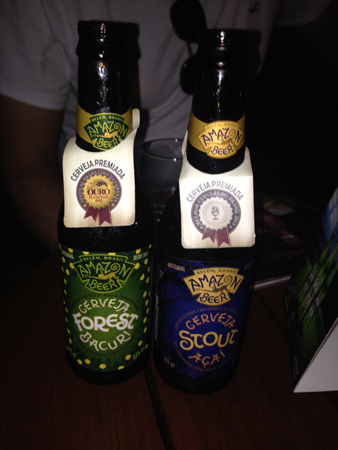 After the volleyball, and all too soon, the promenade became a regular sidewalk, and finally just a cow path. Best of all we seemed in perfect synchronization with a garbage truck that would pull away just as we caught up with it, leaving us in a plume of diesel exhaust and rotting garbage, only to stop 100 yards further up the road to repeat the cycle. After about an hour we finally came to a small supermarket, and beyond it, now in sight, the mall. It occurred to us that we should look for the cachaça here, but given that we had no idea how to pick, and that in any case we were now in sight of the goal, we focused on the limes. We even asked an assistant which of the various lime and lime-like options we should pick for making caipirinhas. She pointed at a stringbagful. Perfect, and they were cheap. When we showed them to Souza who turned out to be something of an expert on the subject he said “what are these?” “Limes for caipirinhas of course, though it is somewhat worrying that you would need to ask.” “Well, first they are not limes, they are oranges. Second, therefore you cannot make caipirinhas. However you can make batidas instead.” For the moment happily oblivious of this error, we schlepped our haul of oranges up the street to the mall, with its blast of air-conditioning, and within moments entered the hallowed portal of the cachaçeria.
After the volleyball, and all too soon, the promenade became a regular sidewalk, and finally just a cow path. Best of all we seemed in perfect synchronization with a garbage truck that would pull away just as we caught up with it, leaving us in a plume of diesel exhaust and rotting garbage, only to stop 100 yards further up the road to repeat the cycle. After about an hour we finally came to a small supermarket, and beyond it, now in sight, the mall. It occurred to us that we should look for the cachaça here, but given that we had no idea how to pick, and that in any case we were now in sight of the goal, we focused on the limes. We even asked an assistant which of the various lime and lime-like options we should pick for making caipirinhas. She pointed at a stringbagful. Perfect, and they were cheap. When we showed them to Souza who turned out to be something of an expert on the subject he said “what are these?” “Limes for caipirinhas of course, though it is somewhat worrying that you would need to ask.” “Well, first they are not limes, they are oranges. Second, therefore you cannot make caipirinhas. However you can make batidas instead.” For the moment happily oblivious of this error, we schlepped our haul of oranges up the street to the mall, with its blast of air-conditioning, and within moments entered the hallowed portal of the cachaçeria.
There must have been 200 bottles on the wall. The assistant found us some “good” ones. There were no prices on anything, so he had to wave the bottle under his pricing machine. About 200 reais or about $70. We all choked. Rumor had it that the average bottle went for 6 to 10 reais. After much wrangling, the cheapest bottle he found was still around $30. You only live once, perhaps we were misinformed, we have no backup plan, we bit the bullet, and bought two bottles for the three of us, one better than the other, and a midprice one for Lucy and Mary. A week later when Adam and I hitched a ride to the Port of Manaus when Souza went to pick up the final night’s entertainment, he showed us where to buy the cachaça he’s plied us with at the demonstration the previous night. It cost us 7 reais a bottle. For the moment happily oblivious of this error too, in the blissful ignorance of thinking we’d done good when in fact we’d been fleeced on all fronts, we celebrated by having a beer, mostly because we couldn’t resist the selection. With that, it was time to beat a retreat to the hotel, and grabbing the taxi waiting outside the door was an easy and unanimous decision.
City Hall
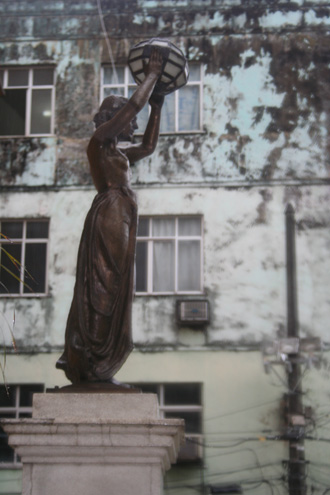 As Murphy so eloquently observed, “Nature is a mother” and although in the temperate zones it can feel like she merely wins in the end, in the tropics it feels like she never relinquishes control. So whether or not one is sympathetic to their motives, one has to be impressed by the sheer determination of the missionaries, explorers, and industrialists who have sought to confront nature, and it has to be said, the natives, of this superficially paradisiacal land. The industrialists aka rubber barons put a crazy amount of money into trying to at least keep pace with the battle, but looking at how even today the buildings are rotting as they are being built the futility of this endeavor is readily apparent.
As Murphy so eloquently observed, “Nature is a mother” and although in the temperate zones it can feel like she merely wins in the end, in the tropics it feels like she never relinquishes control. So whether or not one is sympathetic to their motives, one has to be impressed by the sheer determination of the missionaries, explorers, and industrialists who have sought to confront nature, and it has to be said, the natives, of this superficially paradisiacal land. The industrialists aka rubber barons put a crazy amount of money into trying to at least keep pace with the battle, but looking at how even today the buildings are rotting as they are being built the futility of this endeavor is readily apparent.
So here these few historical buildings are, and if the square was abuzz with life it would be easier to overlook their condition. But without it, the feeling of neglect, no matter how unjust, is almost overwhelming. Add to that the light drizzle, and the whole scene had me reaching for the Prozac.
All our guides were spectacularly well-trained, and as a result were almost impossible to draw out on politics. The Manaus guide was much more open than our Tucano friends, but even he only made vague references to "tough times" and the lack of dependability of politicians everywhere.
Mini-rate hole: Brazilian Economy |
The guide did make one rather nice implication of the world's (and therefore Brazil's) reliance on the US economy for their own well-being: "If you have a headache we feel it here."

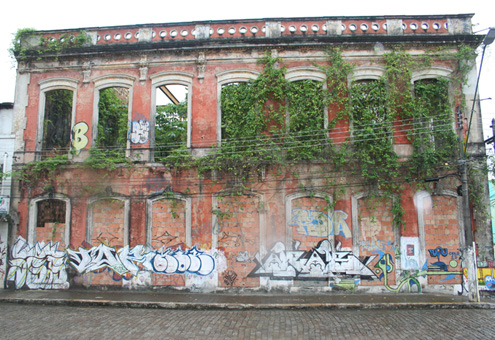
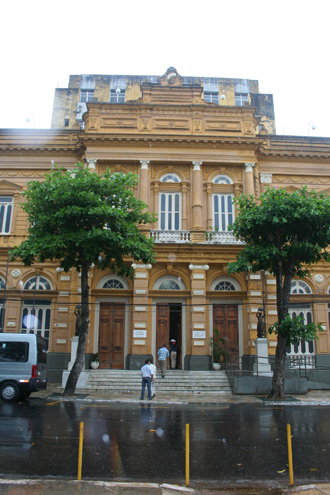 |
It seemed appropriate that there was a light drizzle dampening the city square as we pulled up. It was only about 100 yards on a side, it was important enough to be on our three hour city tour, and it contained a building that had been derelict so long that through the open holes where the windows should have been we could see trees growing inside. A lone couple smooched under the protective awning of the bandstand in the middle of the square. On an attempted cheery note I asked the guide if the bandstand got any use. “Once upon a time. Not in my lifetime as far as I can remember.” The main municipal building had a plaque outside commemorating its opening in 1905, its restoration in 1938, and its re-restoration in 2005. Despite this care and attention, a sapling was growing out of the first floor gutter, and run off from the now-blocked drain stained the wall all the way from there to the pavement. Only one block behind things were completely out of control. I couldn’t wait to move on to the next stop. |
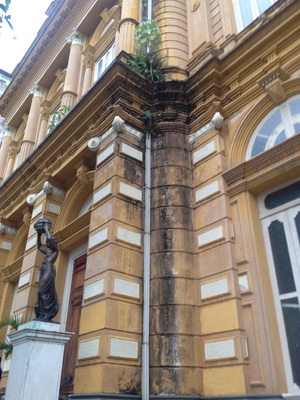 |
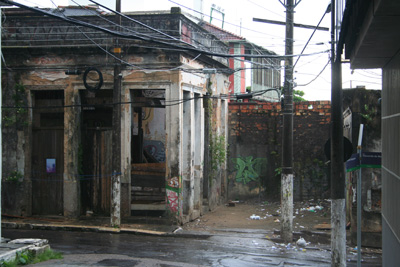
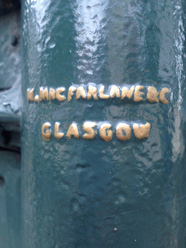
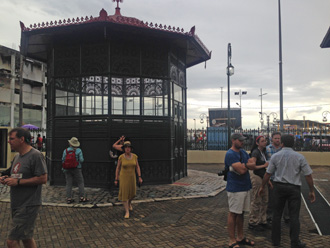
The Market
The Mercado Adolpho Lisboa, aka Mercado Municipal, is a marketplace located in Manaus, Brazil. It lies on the shore of the Rio Negro. The market was constructed between 1880 and 1883. The building was based on the Les Halles marketplace in Paris (demolished in 1971). The building's metallic structures were built in Paris and sent to Manaus by ship. The market is one of the largest open markets in the city (surprise), offering “fresh fruits, spices, fish, meat, souvenirs, traditional indigenous medications and among other products.”
As soon as we walked into the meat section, we were struck by the flies. There weren’t any. “Yes, we think it has something to do with the breeze coming off the river,” explained the guide. “We had a client from Pakistan who was fascinated by it. He said by contrast in his country you can’t actually see the meat.” It was clean and fresh, and was predominantly beef, I didn’t notice anything exotic. Probably a good thing. Passing through an archway we entered the souvenirs and other products section. The guide helped me to try to find a mudder for mashing my limes to make caipirinhas back at home. I thought a nice hardwood one would make a good souvenir. All we could find were pestle and mortars, and I couldn’t see buying a mortar I wouldn’t use just to get the pestle. Brian on the other hand bought a straw hat that suited him so well it looked like he’d owned it for years and Adam found the Brazil nuts he needed.
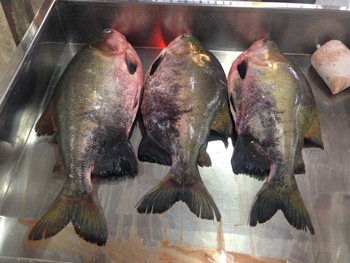 |
Through to the fish market, it was interesting to see the fish we’d been eating all week. The guide told us that “fish is a luxury, and most locals can only afford it on special occasions. Day-to-day, they eat beef.” That made no sense, given how close we were to rivers, and how far from cows, but there we are. We’d been eating rich man’s food all week. I’m glad we were, because the beef we had been offered was no match for the fish. Out the back of the market, a much more lively, not to say aggressive hustle was going on, selling fish directly off the boats lined up in the squalid little canal. | 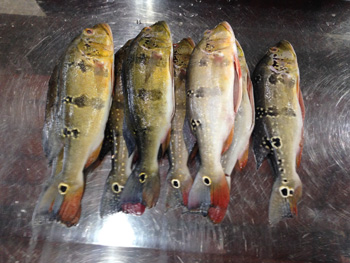 |
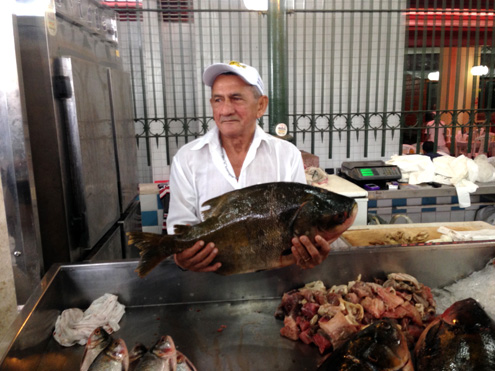 Last stop was the traditional indigenous medications section. BG, Adam and I shared a bag of arapaima fish scales, which make such good nail files that they sell for $5 each in the US, if you can get them. I was curious to know why the fish had such large and hard scales, and the answer was that they are large because the arapaima is one of the largest freshwater fish in the world, (as much as 15 feet!) and they are tough (I kid you not) to make them piranha-proof. Indeed a new science, biomimetics (the study of natural materials from living organisms and the processes that produce them) is studying the scales to reproduce their structure for applications such as soldiers’ body armor, which needs to be both tough and flexible. Just outside the market Tamao bought a whole selection of cachaças to carry home, so all in all a successful visit.
Last stop was the traditional indigenous medications section. BG, Adam and I shared a bag of arapaima fish scales, which make such good nail files that they sell for $5 each in the US, if you can get them. I was curious to know why the fish had such large and hard scales, and the answer was that they are large because the arapaima is one of the largest freshwater fish in the world, (as much as 15 feet!) and they are tough (I kid you not) to make them piranha-proof. Indeed a new science, biomimetics (the study of natural materials from living organisms and the processes that produce them) is studying the scales to reproduce their structure for applications such as soldiers’ body armor, which needs to be both tough and flexible. Just outside the market Tamao bought a whole selection of cachaças to carry home, so all in all a successful visit.
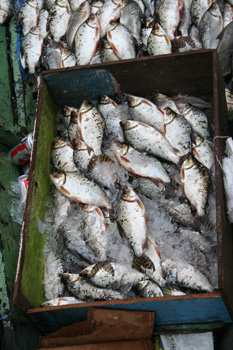
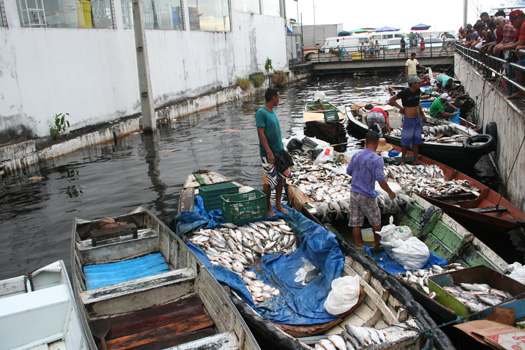
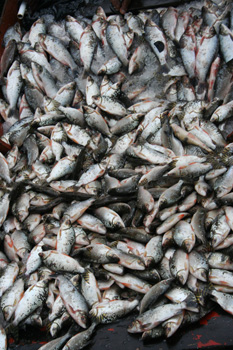
Teatro Amazonas
The Opera House was as grand as we’d been led to believe. It was also “in a constant state of renovation” which suddenly explained why the rest of the city looked so completely run down: everything starts to rot the moment it exists. Half constructed buildings with black mildew all over them were not abandoned, they had just started to rot even before construction was completed. Not so the Opera House which at that moment was pristine, and by all accounts they were in a continuous state of keeping it so. To my great delight, after the disappointment of not being able to see a performance—any performance—the orchestra was practicing during our tour, and we were able to sit for a while and just listen. The guide had interesting things to say about the folks who make up the orchestra, implying that there was a large contingent of Russian and Eastern European musicians who were here putting in time until they were ready for the big leagues back home. There were stories of how hard it was for them to adapt to the, shall we say more relaxed style of this South American audience, none of which can be corroborated, but all of which makes a great deal of sense.

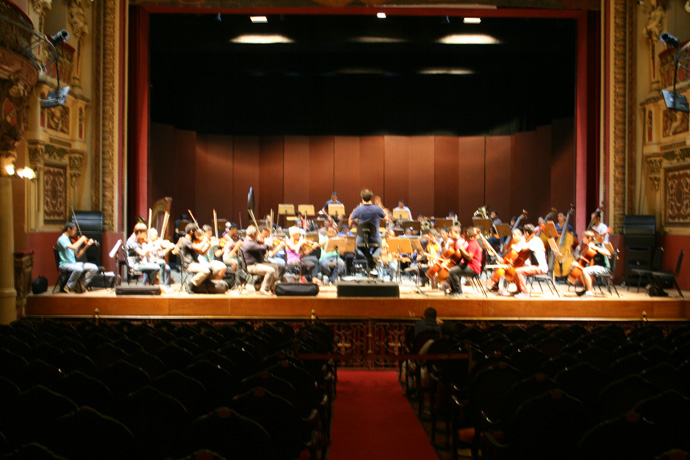
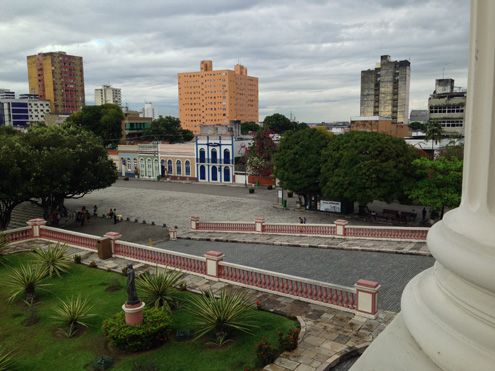 The theater was built in 1896 at the height of Brazil's rubber boom. The rubber barons, who spoke French and sent their linen shirt cuffs to Lisbon to be laundered, spared no expense in building and furnishing the theater, believing their wealth would last forever. They shipped in materials from all over the world, with furniture from Paris, marble from Italy, and steel from England. On the outside of the building, the dome was covered with 36,000 decorated ceramic tiles painted in the colors of the Brazilian national flag. My favorite tit-bit of attention to detail was the use of rubber cobbles in the street outside so that the horses and carriages did not disturb the audience inside. The first performance was given in 1897, with the Italian opera La Gioconda. Opera companies from Spain, Italy and Portugal traveled across the Atlantic to perform in Manaus. Forever turned out to be a mere decade, the theater staging its last opera in 1907, when Brazilian rubber began losing its markets to Far Eastern exporters. Teatro Amazonas then fell prey to termites and tropical storms. There wasn’t a single opera performance in Teatro Amazonas for 80 years until 1990 when the Teatro Amazonas reopened its doors after a three-year, $8-million restoration. The latest renovation of the theater is its fourth, but it has not been used for opera since the 1907 closing.
The theater was built in 1896 at the height of Brazil's rubber boom. The rubber barons, who spoke French and sent their linen shirt cuffs to Lisbon to be laundered, spared no expense in building and furnishing the theater, believing their wealth would last forever. They shipped in materials from all over the world, with furniture from Paris, marble from Italy, and steel from England. On the outside of the building, the dome was covered with 36,000 decorated ceramic tiles painted in the colors of the Brazilian national flag. My favorite tit-bit of attention to detail was the use of rubber cobbles in the street outside so that the horses and carriages did not disturb the audience inside. The first performance was given in 1897, with the Italian opera La Gioconda. Opera companies from Spain, Italy and Portugal traveled across the Atlantic to perform in Manaus. Forever turned out to be a mere decade, the theater staging its last opera in 1907, when Brazilian rubber began losing its markets to Far Eastern exporters. Teatro Amazonas then fell prey to termites and tropical storms. There wasn’t a single opera performance in Teatro Amazonas for 80 years until 1990 when the Teatro Amazonas reopened its doors after a three-year, $8-million restoration. The latest renovation of the theater is its fourth, but it has not been used for opera since the 1907 closing.
In a final act of humiliation, one of the highlights of the tour is a Lego model of the Opera House, itself abandoned until being donated to the theater by a developer who found it while preparing its former location for renovation. But I hear the concerts are awesome again, and vow to make time to attend one if I ever return. The acoustics, I have to say, were lovely.